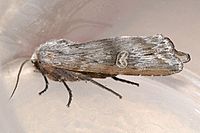Lithomoia germana facts for kids
Quick facts for kids Lithomoia germana |
|
|---|---|
 |
|
| Scientific classification | |
| Kingdom: | |
| Phylum: | |
| Subphylum: | |
| Class: | |
| Order: | |
| Family: | |
| Genus: |
Lithomoia
|
| Species: |
L. germana
|
| Binomial name | |
| Lithomoia germana (Morrison, 1874)
|
|
| Synonyms | |
|
|
The American brindle (Lithomoia germana) is a type of moth. It belongs to a large family of moths called Noctuidae, which are often known as owlet moths. This moth is special because of its unique appearance and habits.
Contents
What is the American Brindle Moth?
The American brindle moth is a fascinating insect. It gets its name from its patterned wings, which look a bit like a brindle dog's coat. These moths are nocturnal, meaning they are active at night. They play an important role in their ecosystems.
Where Does it Live?
You can find the American brindle moth across a wide area of North America. It lives from Alaska all the way to Newfoundland. You can also spot it further south in places like Pennsylvania, Colorado, and Oregon. This wide range shows how adaptable these moths are to different environments.
What Does it Look Like?
The American brindle moth has a wingspan of about 40 millimeters (which is about 1.5 inches). Its front wings are a light gray color. They have streaks and shades of darker gray and brown, helping the moth blend in with its surroundings. The back wings are a gray-beige color and get darker towards their edges.
When this moth rests, it often rolls its wings tightly around its body. This makes it look a lot like a small twig! This clever trick helps it hide from predators like birds.
What Does it Eat?
The American brindle moth has different diets depending on its life stage.
- Larvae: The young moths, called larvae or caterpillars, enjoy eating leaves. They feed on various trees and woody shrubs. These plants usually belong to the Salicaceae family (like willows and poplars) and the Betulaceae family (like birches and alders).
- Adults: Once they become adult moths, their diet changes. Adult American brindles drink nectar from flowers. They especially like the nectar from goldenrod flowers. Nectar gives them energy for flying and laying eggs.
Life Cycle and Habits
Adult American brindle moths are active during specific times of the year. You can usually see them flying from mid-April to early May. They then appear again from mid-August to the beginning of October.
An interesting fact about this moth is how it survives the cold. It hibernates as an adult moth. This means it finds a safe place to rest and slow down its body functions during the winter months. When spring arrives, it wakes up and becomes active again.
Different Kinds of American Brindle Moths
Scientists have identified a few different types, or subspecies, of the American brindle moth. These subspecies are slightly different from each other, often based on where they live.
- Lithomoia germana germana
- Lithomoia germana morrisoni (found in Alaska)
- Lithomoia germana albertae (found in Alberta, Canada)

